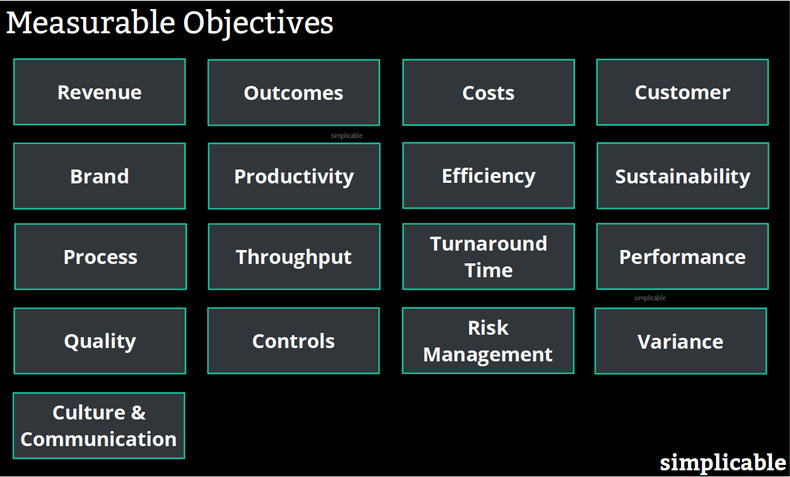

Revenue
It is often preferable to measure things in terms of money where possible. This is particularly true for a business unit that is responsible for revenue generation. For example, a sales manager may measure as many objectives as possible in terms of sales revenue.Outcomes
Non-profit organizations are often primarily concerned with outcomes as opposed to revenue. For example, a children's charity that operates in poor countries may measure results in terms of education, safety or health such as the rate of a childhood disease.Costs
Back office teams that have no mandate to generate revenue often measure objectives using cost savings. For example, an IT manager might measure implementation of a new system in terms of reductions in IT opex or money that the system saves business units.Customer
Measuring strategies in terms of the customer using metrics such as customer satisfaction, customer loyalty and customer lifetime value. Customer metrics are often considered a close proxy for revenue. For example, a hotel that improves customer satisfaction will typically see stronger ratings and demand for inventory.Brand
Advertising and promotion may be measured in brand metrics such as brand recognition, brand awareness and top of mind. This is also thought to translate well to revenue.Productivity
Improving your output for an hour worked. For example, a sales system measured by how many leads sales operation staff can qualify in an hour.Efficiency
Improving your output for a unit of non-labor inputs such as materials, energy and machine time. For example, improving a production line to produce more units per hour.Sustainability
Making things better for communities or the environment. For example, a device recycling process with a goal to reuse 100% of parts and materials.Process
Process metrics such as error rate or cost per unit.Throughput
Improving the total amount of work produced by a process. For example, a software development team with a goal to produce more story points in a sprint.Turnaround Time
Improving the speed of a process. For example, answering customer email inquiries in an hour instead of two.Performance
Improving the performance of a product or service. For example, making software faster as measured by average response times.Quality
Increasing the value of products and services to customers. For example, a chef who makes a dessert more tasty and satisfying. Measured with customer feedback such as a survey.Controls
Implementing controls for purposes such as security, compliance and risk management. Often measured by the coverage rate of controls. For example, a bank with thousands of systems that has a goal to implement patch management for 90% of systems by the end of a quarter.Risk Management
Risk management is often measured by the amount that you can reduce risk exposure. For example, a manager might have an objective to reduce risk exposure by 50% for a project. This is measured as the difference between the risk exposure of identified risks and the risk that remains after risk treatment.Variance
Measuring the difference between your plans and your execution using metrics such as schedule variance and budget variance.Culture & Communication
Where improvements are difficult to measure it is often possible to use surveys. For example, a manager who wants to improve team culture can measure employee satisfaction and engagement before and after the initiative with a survey.| Overview: Measurable Objectives | ||
Type | ||
Definition | An objective that can be measured with a number. | |
Related Concepts | ||

































